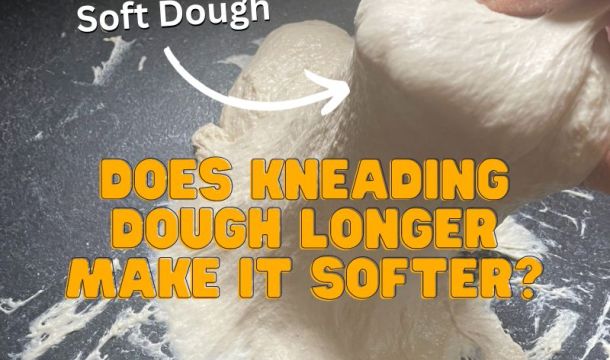
How To Master Dough Hydration

One thing for sure is flour absorbs water. Doing this allows the protein in the flour to hydrate, which helps the gluten to relax and unwind. It can then form a network that is able to trap gas produced by the dough fermentation process. Getting the level of water to flour ratio correct often causes novice bakers to panic – as well as a messy kitchen!
So, how to get dough hydration right? I’m going to explain how to calculate the hydration level of a recipe, why it changes with different types of flour and how changing the amount of water used in a recipe alters the quality of the bread.
How to calculate the hydration level of a recipe
The amount of any ingredient used in a bread recipe is determined by a pre-set percentage of the total amount of flour. It’s these bakers’ percentages that are the building blocks of all bread recipes and justify why bread recipes should always be measured in grams!
Here’s how it works:
If a recipe uses 1000g of flour and 600 grams of water, we divide 600 by 1000: 600 / 1000 = 0.6 We multiply this by 100 to find our percentage of water used in the recipe: 0.6 x 100 = 60% This means this recipe is 60% hydration, typical of traditional French bread.
But, this isn’t how you work out percentages?
Yes, I agree that 60% of the flour isn’t going to mean 60% of the total recipe, which makes the above hydration calculation mathematically wrong. Calculating the water (and the other ingredients) from the weight of the flour is the way bakers and recipe creators work to produce bread recipes! And work it does.
Calculating the amount of water required:
If we want to make a loaf that’s 65% hydration using 600 grams of flour, we pop this into the calculator:
600 x 65% = 390
Or for those of us without a % button (or prefer “old-fashioned” maths):
600/100 = 6 6 x 65 = 390
Now we know we need 390 grams of water in our 65% hydration recipe.
Should the flour and water in a sourdough starter be included in the hydration of the recipe?
Yes, they should. Most sourdough starters follow a 1:1 ratio of water and flour. This means we add half of the starter weight to the flour and the other half to the water weight.
Should I include other liquids in the hydration of the recipe?
If you are using liquids other than water, they could be included in the hydration of the recipe. However, it get’s overly complicated, so many bakers don’t calculate the water content of every ingredient. They just take into consideration the water content in the ingredients as we’ll see in the next section.
The water content of common dough ingredients:
- Milk = 87% water
- Egg = 74% water
- Butter = 15% water
- Olive oil = 0.2% water (although as it is a liquid at room temperature it should be included as 100% liquid)
How to adjust the amount of water in a bread recipe when adding ingredients containing water
A recipe’s water content can be adjusted when adding water-containing ingredients. You’ll need to know the amount of the ingredient to be added and the water content of that ingredient. Divide the weight of the ingredient by 100 and multiply this number by its water content.
For this example, we’ll add 200 grams of butter which is 15% water. The recipe currently uses 500 grams of water:
First, we'll divide the weight of the butter by 100 and multiply this number by its water content. 200/100 = 2 2 x 15 = 30 This gives an answer of 30 grams. We then remove 30 grams of water from the recipe. 500 - 30 = 470 The water required now is 470 grams
How to convert a recipe from water to milk
If you wish to switch 100% of your water to milk, there’s a simple calculation you can do. As milk is 87% water, you’ll need to use more milk than water to avoid a dry dough. To discover the amount of milk you should use, take the water amount in the recipe, divide by 87 and multiply by 100.
An example where converting a recipe with 500 grams of water to be replaced by milk:
Water = 500 grams 500 / 87 = 5.75 5.75 * 100 = 575 The recipe requires 575 grams of milk
Alternatively to discover the necessary baker’s percentage of milk, divide the percentage of water by 0.87.
| Percentage | Quantity required where 770 grams of flour is used | |
| Flour | 100% | 770 grams |
| Water | 65% | 500 grams |
| Milk | 75% | 575 grams |
What percentage of water should I use in bread?
Standard hydration rates for bread dough are 65% for white bread and 70% hydration for wholemeal recipes. Long fermented bread uses a higher water ratio. Artisan bakers can use 100% hydration and even higher. In contrast, bread with a close-knit crumb can be as low as 55% water.
Why water absorption matters
What is the problem with not using enough water?
Dough with a hydration level that is too low also prevents the gluten from being able to unwind and stretch. This creates a weaker dough structure with poor gas retention qualities, lowering the oven spring. A dense, dry crumb is also unpleasant to eat and stales quickly.
Is a higher hydration dough better?
Water is the cheapest ingredient in bread. It makes sense that the more water incorporated lower the production cost of the bread. Water allows the gluten to stretch and develop a strong gluten structure. It also provides moisture to keep the bread soft.
Can there be too much water in a bread recipe?
There’s a balance between a high-hydrated dough with a soft, open crumb and a problem. If the dough is too wet, excess water gets in the way of the developing gluten structure. The excess water almost works like a lubricant, protecting the gluten when kneading and preventing a network from developing. It’s also hard to work with!
The weight of the dough increases, and as its ability to retain gas lowers, the weakened structure often collapses. This collapse can occur when rising (it never rises) or commonly after cutting and baking. Though if the bread doesn’t collapse, large air bubbles alongside an irregular crust are likely. The additional moisture increases the risk of moulding too.

This sourdough loaf had too much water. It was lucky not to collapse, although it didn’t hold its shape very well.
Many bakers get excited by high hydration doughs with more than 80% water. But, giving the flour the right amount of water as opposed to the most amount of water produces better results -and less work for your dough scraper!
How to use hydration to make a softer crumb
As discovered in a forthcoming article, an essential feature of soft bread is a close-knit crumb. To achieve this, we reduce the amount of water in the recipe. Soft bread tends to have dough hydration of less than 60%.
When to adjust the water in a recipe
Why does dough remain sticky if I follow the recipe exactly?
All flour types require different water ratios to hydrate the flour correctly. So when following someone else recipe, there will still be variables in the type of flour used as well as other factors including; humidity, temperature, mixing efficiency and water quality.
Lower protein flour absorbs less water. So when using higher protein bread flour, the water should be increased.
If your dough is sticky, allow plenty of time for a long period for bulk fermentation (in the fridge if possible) and use stretch and folds instead of kneading to strengthen the gluten gradually.
If using high protein flour, how much should the water increase?
For every 1% increase of protein in the flour, the hydration percentage of the recipe should rise by 2.5%. The quality of the protein also makes a difference in the amount of water absorbed by the flour. This is represented by testing the flour with a farinograph.
Dough hydration calculator
Here’s a great tool for working out bakers percentages:
If you’ve enjoyed this article and wish to treat me to a coffee, you can by following the link below – Thanks x

Hi, I’m Gareth Busby, a baking coach, senior baker and bread-baking fanatic! My aim is to use science, techniques and 15 years of baking experience to make you a better baker.
Table of Contents
- How to calculate the hydration level of a recipe
- Calculating the amount of water required:
- Should the flour and water in a sourdough starter be included in the hydration of the recipe?
- Should I include other liquids in the hydration of the recipe?
- How to adjust the amount of water in a bread recipe when adding ingredients containing water
- How to convert a recipe from water to milk
- What percentage of water should I use in bread?
- Why water absorption matters
- When to adjust the water in a recipe
- Dough hydration calculator
Related Recipes
Related Articles
Latest Articles
Baking Categories
Disclaimer
Address
53 Greystone Avenue
Worthing
West Sussex
BN13 1LR
UK







